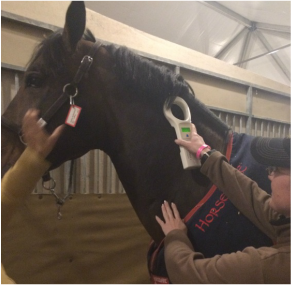|
Mary O’Connor, USHSBA President and USEF Horse Recording and ID Task Force member
 FEI jumpers were scanned for chips at the 2015 Washington International Horse Show. FEI jumpers were scanned for chips at the 2015 Washington International Horse Show.
Keeping track of offspring after sale was a high-priority concern expressed by breeders to those who came together to discuss formation of the USSHBA more than five years ago. Once established, the group’s first efforts were dedicated to making the voice of breeders heard on this issue at the highest levels of equestrian sport governance, helping lead to the formation of the USEF’s National Horse Recording and ID Task Force. The Task Force was created in July of 2014, and oversaw passage of new USEF Horse ID rules the following year and landmark 2016 rule changes requiring microchips a) for all USHJA competitors to earn points in their respective divisions beginning with the 2018 competition season and b) in order to participate at all the USEF/USHJA competitions in the 2019 competition season.
The enactment of these new policies will be a watershed for sport horse breeders on the issue of positive ID. They are to be gradually phased in and will be fully implemented as of December 1 2018 (for the 2019 competition year). Although their current rules do not require microchipping, it is anticipated that other disciplines (Dressage, Eventing, etc) will eventually follow suit. All who participate in activities other than H/J are advised to encourage those involved in their discipline group governance to adopt similar policies. Q. What can breeders do now to provide the greatest assurance that they will be able to track the sport careers and changes of ownership of the horses they produce? There are two steps to take. First, have all young stock microchipped, and second, take the initiative to ensure they are each Life Recorded with USEF and that the microchip number is included on their USEF Horse Recording Application Form. The fee for recording foals in their first year is modest ($35 as of this posting). Although many breeders are USEF members, it is not necessary to be a USEF member either to record a foal or to be the owner of record. With an initial USEF recording in place, it will be a rule infraction regardless of discipline if a future owner attempts to obtain a new USEF recording rather than properly notify the USEF of a change of ownership and/or change of name. Association of the implanted microchip number with a foal’s initial USEF Life Recording will provide assurance that any subsequent transfers of ownership and/or name changes will be searchable in the USEF’s database using the microchip number. Q. What type of microchip must be used to comply with these rules? The requirements follow those of the FEI and EU: a fifteen digit ISO compliant 11784/11785 chip, implanted in the nuchal ligament. Your equine veterinary specialist is the best source of information if you are unsure of how to obtain the correct chip type. Q. What other information can be provided on the USEF Life Recording Application form? There are data fields for breed registry name and number of the foal, sire, dam, and damsire as well as markings. There is a data field for the USEF number of the breeder, but again, it is not necessary to be a USEF member to record your foal or to be listed as the owner of a foal. Q. Once horses are microchipped and USEF Life Recorded, are there any other steps to take? Be sure to include the microchip number with your your application for breed registry papers, and when you receive it, also notify the registry of the USEF Recording Number of your foal. A few registries (such as the American Hanoverian Society) will provide for USEF recording of foals in their registration process so a separate USEF application will not be necessary. Discipline group registrations may also be required in some instances. Q. What if I have further questions? Send your questions to [email protected]. The USSHBA is currently in the process of compiling information by registry regarding microchip and registration policies, and will post this information with links when this is completed.
Thanks to Diana Dodge, Nokomis Farm, Old Dominion Equine Associates, and Tim Kammerer for their assistance in making this video.
0 Comments
|
Details
AuthorsA collaborative effort produced by the USSHBA Education Committee, USSHBA members, and our partners. Archives
January 2021
|
